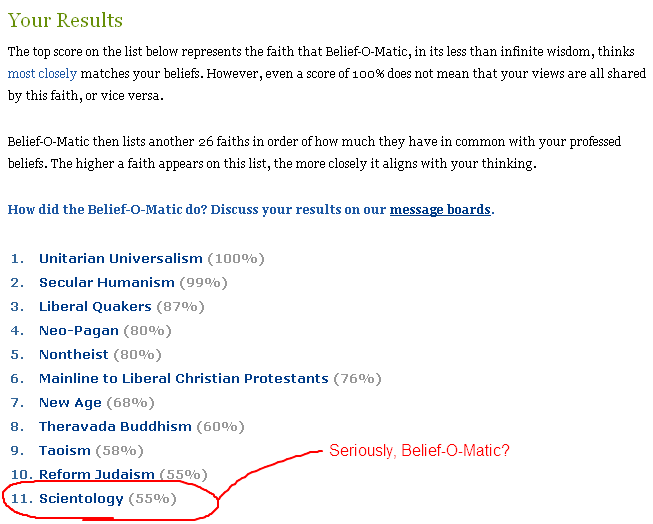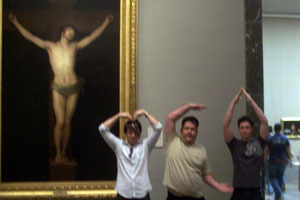I find it amazing that people look at the chaos and the beauty of the world and somehow come to the conclusion that there is a god. I know that sounds like it’s backwards, but
I mean it. The other day I was watching a spectacular sunset. The sun hung low in the sky and painted a picture of orange, pink, and red across the wispy clouds, and I found myself
thinking, “Wow; that’s absolutely beautiful. How cool is it that we’ve evolved to be able to appreciate that?” People have been appreciating the colours of sunsets for thousands of
years, of course, and it’s no less amazing since we came to the realisation that the Earth is not the centre of the universe (what a stir that kicked up amongst the devout!), that the picture painted by a sunset is just a result of
atmospheric effects, and that our ability to enjoy things which are aesthetically pleasing is the result of a long line of evolutionary changes in our long-distant history. I didn’t
need to think about any of those things to enjoy that uncommonly pleasing moment during my walk home from work. Most folks don’t . You could probably just about put a man on the moon
without thinking about the relativistic implications of non-geocentrism, never mind the living of your day-to-day-life.
A friend of mine wrote a post in her blog (sorry; she’s protected it, most of you can’t read it) a little while ago
about how she’d come, over the course of her life, to her current beliefs. This kicked off a few dozen comments including one from me, promising that I’d write something similar in the
near future. This is it.
My upbringing, for the most part, was very much secular. My parents seemed to be careful not to try to overly influence me or my sisters in any particular religious direction, giving us
a childhood which was, to all intents and purposes, agnostic, with as little bias as they could manage. This is best expressed, I think, through an anecdote: I remember quite vividly a
discussion that took place between one of my sisters – quite young at the time – and my mum. My sister came into the kitchen where my mum and I were sat and asked, “Where do rabbits
come from?”
“Well,” said my mum, in her most matter-of-fact way, “Do you remember how we were talking about how mummies and daddies make babies?” At this point, she had assumed that this was going
to be an elaboration of the “birds and bees” talk they’d had some time ago. Except about rabbits and… er… rabbits.
“No, no, no,” my sister replied, “I know all that. I mean: where did the first rabbits come from?” This was, of course, a whole different topic.
“Where did the first rabbits come from?” my mum repeated, “We’re not completely sure; but there are two main schools of thought about it. Some people think that rabbits came from other
animals which were a lot like rabbits, but not quite; and they came from animals that were not quite like them, and so on, until eventually; a long long time ago, every animal
came from tiny little animals that were a lot like germs. Some other people think that rabbits – and everything else; even people – were created on purpose by someone super-powerful,
who they call ‘God’.”
I was impressed. This was a basic summary of the widest possible views of many evolutionist and creationist philosophies, summarised into a couple of sentences that a precocious primary
school child could comprehend. My mum had successfully condensed the beliefs of over 90% of the world’s population into something that made sense on any level; and, better yet, she’d
done so without needing to superimpose her own beliefs on the top.
My sister, evidently, was also impressed. She stood quite still for some time, contemplating what she’d been told and visibly going over these two concepts in her mind. Eventually, she
piped up, “I think that rabbits came down from the sky like bogies from God.” And that was that: she’d been given the space to make up her own beliefs from the evidence given.
Undoubtedly these beliefs have changed over her years (I’m pretty sure she no longer subscribes to “Mucusism”), as she’s had the chance to be exposed to more evidence from both these
major camps, and probably from some systems of belief that don’t directly agree with either one or the other. I’m sure if she’d asked my mum what she believed, she’d have got
an honest and reasoned answer. As it happens, it’s rather irrelevant.
We’re all born atheists: we have no concept (or the mental faculties to comprehend) of deities, and therefore we have no belief in them. Later; at the first point we discuss religion,
or question the possibility of a supernatural creator, we become momentarily agnostic, and then start to form a set of religious beliefs of our own. This is based on the evidence we are
presented with, and our young and malleable minds can easily be shaped by well-meaning individuals like our parents and teachers. My primary school was typical of others in our area and
at that time: we sang hymns, had prayers, even had “scripture” lessons (which were later replaced by religious education when the school adopted a more secularist attitude), and were
exposed to other elements of Christian mythology. Like most rational people of any age, I came to understand children’s’ stories like Noah’s ark to be exaggerated (at best), and
probably just metaphorical or entirely imaginary. However, primary school did expose me to a peer group laden with children already indoctrinated into a belief system that I found to be
complicated, confusing, and un-necessary. Arguments for the existence of a supreme being, woven into stories and songs, challenged me with questions that I didn’t yet have the
philosophical depth-of-thought to be able to contradict. Simply put; I wasn’t sure what to believe. And that’s just fine.
There’s no problem with agnosticism, especially amongst children (who, lets face it, are given a simplified model of the world in all senses anyway – a necessity for their survival and
a means to provide them with valuable information without having to resort to unanswerable questions). But amongst a group of 10-year-olds who haven’t yet learned to question the
“facts” given to them by their evangelistic parents, it’s difficult to be the one to say, “I can’t see any reason that God has to exist at all.” Many of the most popular
arguments for the existence of God are so simple that a child can explain them, and the reason for that is simple: they’re not very good arguments (it’s sad that so many theists
continue to use these flawed arguments into the adulthood, unwilling to listen to their faults). Nonetheless, it’s not easy to defend an agnostic viewpoint when you’re unready for the
kinds of arguments you’ll come up against. In hindsight, these (rare) playground discussions would have been easier had my parents brought me up as an atheist, rather than simply
areligious. However, that – I think – wouldn’t have given me the open-mindedness to actually investigate these beliefs that others held, which, in turn, has ultimately made me surer of
my current beliefs.
By the time I was 14 I’d formulated a well thought-out set of philosophies in my mind; primarily an atheistic one, with sufficient unanswered questions and seemingly equally-viable
explanations to be agnostic on particular issues. It was at about this point that I realised that the idea of an omnipotent, omniscient deity that is concerned with human behaviour was
completely ludicrous to me. I had no difficulty seeing the similarities between belief in a god and belief in, say, Santa Claus, or with the fact that while neither is entirely
disprovable, this does not mean that existence and non-existence are equally likely. It’s about this point that I became particularly fascinated with religion in general. I tried to
learn as much as possible about as many as possible, and I began to love hearing about what people believed and why. Content with my own model of the world – with its few unanswered
questions themselves not requiring God (and certainly not the God described by any religion I’d ever come across, with all their hypocrisies and illogical arguments) to fill in the
blanks – I turned to trying to understand others.
I read a lot about religion and about philosophy. I became familiar with the major arguments used by theists for their beliefs, and by atheists for their disbelief (although I’ve always
found the latter to be less necessary, just as arguments against the existence of anything are less necessary by scientific theory – the burden of proof comes from the hypothesis of
existence). And everything I read confirmed more and more for me how illogical and unnecessary this image of a god was, most of all a god anything like those that the major religions
subscribe to. And, gradually, over the coming years, I came to iron out many of the other quirks in my beliefs (by, for example, finding myself a determinist without tripping over any
of the usual, often theistic in nature, arguments against it).
The only significant change to my religious views of late has been a reduction of my tolerance for the activities of others as a result of their religion. While I’ve previously been
very open to other people’s beliefs, not caring what other people believe (however wrong I think they are), I’ve more recently begun to see how dangerous religion can be when used as an
excuse for some awful things. While I don’t believe it’s true to say that most wars are started over religion, it is true to say that religion provides an excuse for such
behaviour. And somehow, lately, religion has become something that’s taboo to argue against.
In a legal case a few years ago by a San Diego student against his school – who had banned him from wearing a t-shirt that carried an anti-homosexual message at school – the student
made his case not on the grounds of freedom of expression but on the grounds of freedom of religion. Had he tried under the former, he would undoubtedly have failed, because
while it’s okay to express whatever opinions you like, the court would have said, it’s also okay for schools to maintain order and a civil atmosphere. But under an argument of religion,
he was far more likely to be untouchable – in the current socio-political climate, no judge wants to be seen to infringe upon somebody’s religious views. Small cases like these help to
enshrine (hah!) religion into a status where it can’t even be criticised, even where it’s used as justification for some of the most disgusting acts of genocide, war, hatred, and
terrorism. It’s a big scary world, and while it might still be as big and scary without the fundamentalist theists, at least we’d have removed from people an irrational excuse for their
actions. And meanwhile, the majority of people still brainwash children with disputable beliefs that they haven’t got the cognitive abilities to question.
I’m grateful to my parents for giving me the chance to be whoever I wanted to be.
So; there’s a 10-minute summary of how I came to the beliefs I currently hold. Perhaps in another couple of decades I’ll write it again. In the meantime, I’ll happily argue the
non-existence of God with any of you until the sun goes down, but I’d still prefer to hear what it is that you believe, because, for the time being, religion still interests me far more
than fighting over it does.
Further Reading
Some stuff other people have written, that I think you should read:








